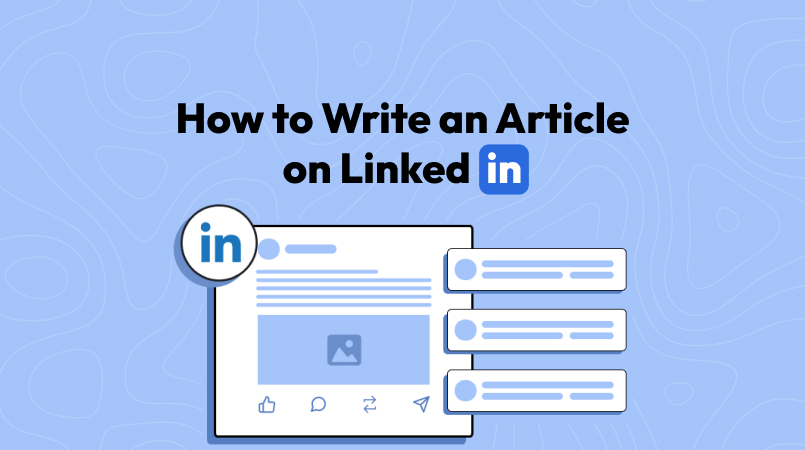
If you don’t nail your LinkedIn article writing approach, nobody’s going to stick around to read your content.
This is something most professionals completely miss when they first start publishing on LinkedIn & their articles get buried.
Writing quality LinkedIn articles matters for your professional brand & thought leadership.
So today, we’re covering exactly how to write an article on LinkedIn that grabs attention & keeps readers hooked.
6 Steps on How to Write an Article on LinkedIn That People Actually Want to Read
Step#1: Know Who You Are Writing For
You need to be clear about your audience from the start.
And you need to speak their language. This is what separates your articles from the boring pieces of content flooding LinkedIn feeds.
Here are some ways to nail your audience targeting:
Find Their Daily Struggles: What keeps them up at night? Are they fighting for budget approval, dealing with difficult team dynamics, or trying to prove ROI on their initiatives?
Use Their Own Words to Understand Them: Use the same phrases readers use when venting to colleagues or posting in industry groups.
Solve Real Problems They’re Facing Right Now: Your readers should walk away thinking, “You understand what we’re dealing with.”
“Analyze your LinkedIn analytics and comment sections to see which topics or pain points spark the most reactions. Your audience is telling you what they care about—listen closely.”
Step#2: Pick Topics That Make People Stop Scrolling
Don’t write about generic topics everyone else is covering.
Before you choose what to write about, think about what would make your ideal reader pause their LinkedIn scroll & actually click.
Here’s what works:
Current Industry Drama or Hot Topics: People love reading takes on what’s happening right now in their field.
Contrarian Viewpoints That Challenge Conventional Wisdom: “Why the advice everyone gives about X is totally wrong” gets attention.
Behind-the-Scenes Stories from Your Career: Real experiences beat theoretical advice every single time.
“Answer common questions you’re asked during networking or mentoring. If people keep asking, it’s likely that others are also seeking answers.”
Step#3: Craft Headlines That Demand Attention
People scrolling LinkedIn are ruthless.
They’ll decide whether to read your article in about 2 seconds based on your headline alone.
So your headline better be good.
Here’s what works:
Numbers & Specifics Grab Eyeballs. “5 Mistakes That Killed My First Startup” performs better than “Common Business Mistakes.”
Questions That Hit Pain Points: “Tired of Meetings That Go Nowhere?” makes people think “Yes, that’s exactly my problem.”
Bold Statements That Make People Curious: “The Networking Advice That Ruined My Career” makes people want to know more.
“A/B test your headlines by turning them into short posts first. See what gets more engagement, then use the winner as your article title.”
Step#4: Hook Readers with Your Opening Lines
Your first paragraph is make-or-break time.
If your opening doesn’t grab attention immediately, people will bounce faster than you can say “thought leadership.”
Here’s how to nail your article openings:
Start with a Story That Relates to Your Main Point: Personal experiences make people care about you & your message.
Share a Surprising Statistic That Challenges What People Think They Know: Numbers that shock people into paying attention work like magic.
Present a Problem Your Readers Face Daily, Then Agitate It: Make them feel the pain of not solving this issue, then position your article as the solution.
“Use strong emotional language to mirror how your audience feels. If your reader feels seen in the first few lines, they’ll keep reading.”
Step#5: Structure Your Content
Don’t create walls of text that make people’s eyes glaze over.
Before you write your main content, create subheadings that logically break down your key points.
Think of each section as its own mini-article that dives deep into one specific aspect of your topic. This makes it way easier to cover everything thoroughly without overwhelming readers.
Here are some more tips for structuring content that gets read:
Use Bullet Points to Highlight Key Takeaways: They make complex information digestible.
Keep Paragraphs Short & Punchy: Long blocks of text kill engagement on LinkedIn.
Add White Space Between Sections: Give readers’ eyes a break so they don’t get tired.
“Include visual elements like emojis, bold text, or LinkedIn’s native formatting tools (such as numbered lists or dividers) to break the monotony and guide the reader’s attention.”
Step#6: End with Purpose & Drive Action
People who read your articles all the way through are your most engaged audience.
They’re the ones most likely to connect with you, share your content, & potentially become clients or collaborators.
Make the most of that attention by ending with a clear call to action.
Ask them to do something specific:
- Connect with you to continue the conversation
- Share the article if it resonated
- Comment with their own experiences related to your topic
For extra engagement, ask an open-ended question that gets people talking in the comments.
Make it conversational & directly related to your article topic.
“You can also link to a related resource (like another post or article you’ve written) to keep the engagement going and provide more value.”
Building relationships with your readers is what turns one-time readers into long-term followers & advocates.
Bottom Lines
You need to approach LinkedIn article writing strategically. Write articles that build your reputation & open doors. Because it takes way more than good grammar & spell-check to get noticed & build influence on LinkedIn.
Most professionals learn this through years of trial & error, posting content that goes nowhere.
But you can skip that frustration by focusing on what actually works: authentic, valuable content that speaks directly to the people you want to reach.
Continue to improve by tracking what performs well. Monitor views, likes, comments, and shares, and use that data to refine your future content strategy.

Factsinsight.com is a leading blog that focuses on creating high quality, interesting and useful content about technology. We are a group of experienced writers who know a lot about the world of tech and love to stay abreast of the latest trends and developments. Our aim is to give useful and real knowledge to our people.
